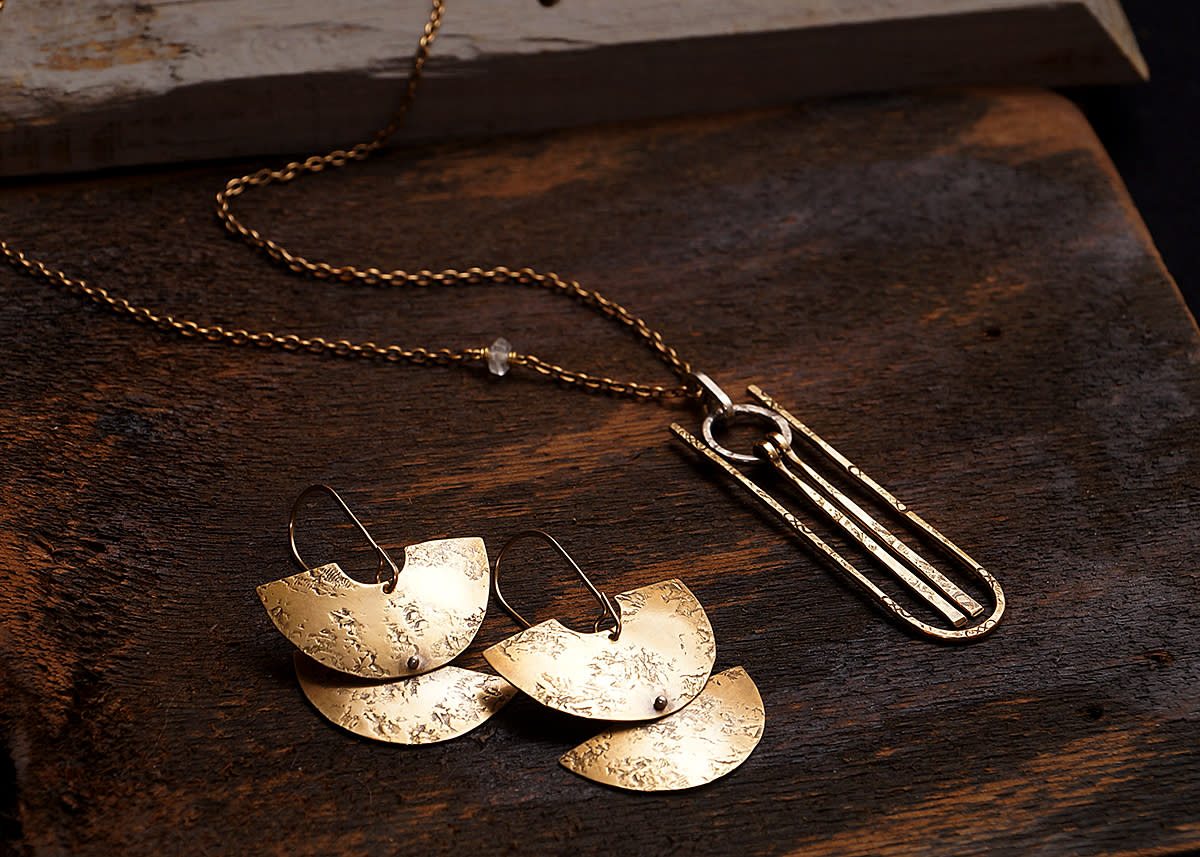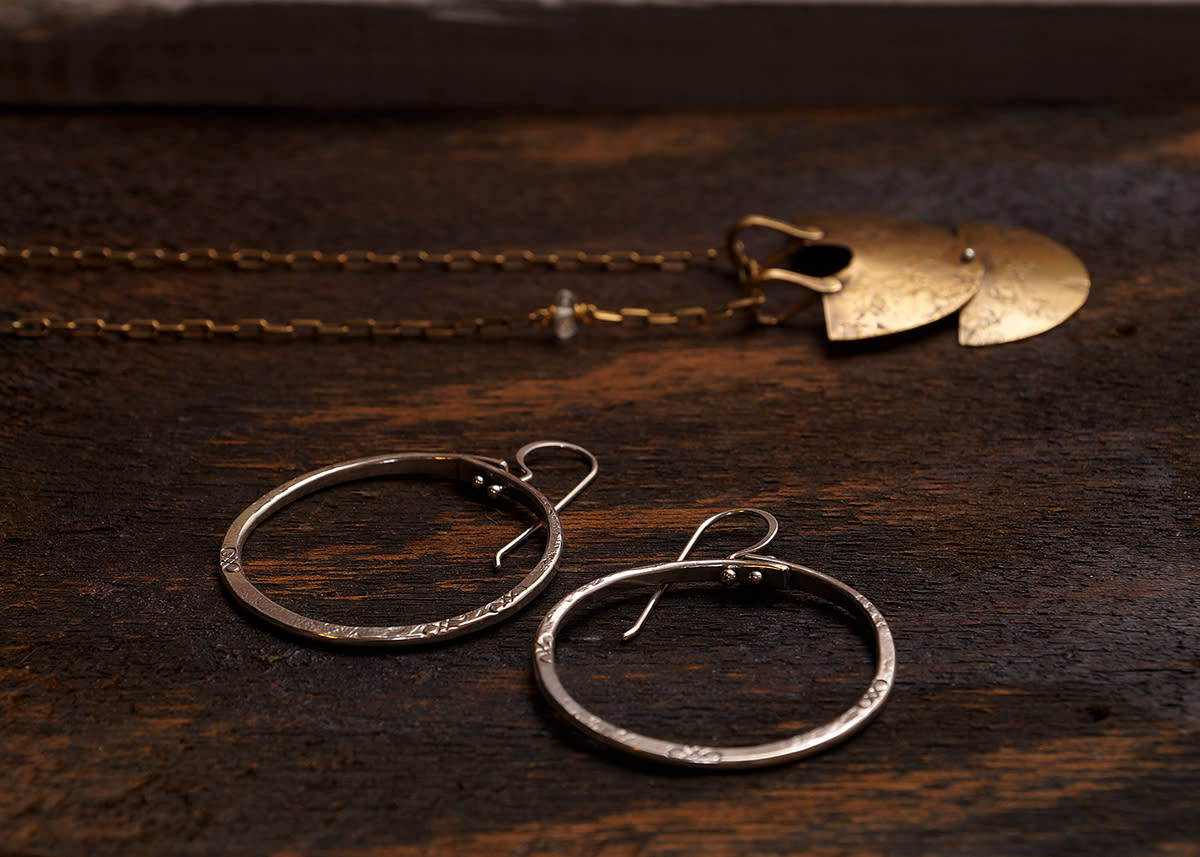Jewelry designer Alex Ozers forges brass and copper into wearable art that feels aged by desert forces
By Sally J. Clasen
Jewelry designer Alex Ozers used to make large-format paintings with a brooding, agnostic message. But now he’s transparent about his simple but well-intentioned artistic pursuits:
“I make pretty things,” he says.
Ozers’ jewelry line, called From the Reliquary, lacks a socio-political statement because he’s more interested in creating objects that people want and will enjoy. And that comes in the form of hand-forged metal earrings, rings, bracelets and necklaces with a time-worn aesthetic. A reliquary, it’s worth noting, is defined as a “container for relics”.
Ozers grew up in Phoenix’s East Valley and graduated with a degree in fine art from Arizona State University in 2009. As a student, he was focused on interpreting the post-modern struggles of society on canvas. After college, however, he quickly realized that creating art with an internal cultural conflict wasn’t easy to sell or something that would naturally find a home above a client’s couch. So he shifted into jewelry fabrication.
Ozers’ sculptural pieces mimic the detail-rich layers, patterns and textures of the Sonoran Desert. And much like the desert’s rugged and sun-baked edges, his jewelry isn’t always shiny or perfect. In fact, he leans toward imperfection.
“As a student, I’d get into trouble in class because I wanted to dig through the scrap bucket to find the ‘throwaway’ metal,” Ozers says. “I’m more intrigued by them because, to me, they have more integrity.”

Ozers uses torch fire, patina and tools like hammers, stamps and rolling mills to produce the distressed, weathered effect of his jewelry line. He sometimes uses sterling silver, but brass and copper are his go-to foundations because they are more forgiving. “It costs more to correct sterling silver,” Ozers says. “You have to be certain what you are going to make.”
With brass and copper, Ozers can discover the vision in the process, which allows him to shape one-of-a-kind designs that appear plucked from another time—and, in some cases, another world—yet still have a contemporary edge.
Ozers’ Arizona roots strongly influence his artistic sensibilities, but nods to other earthly destinations can be spotted in his fabrications. The Alvour collection, for example, emits a Scandinavian forest vibe, and the Canyon series is a divergent desert mashup of Middle Eastern architecture and Southwestern elements.
“I’m interested in the wear and tear of things,” he says. “In my opinion, something time worn is a feature rather than something that needs to be fixed. It’s a romantic notion, like a Westfield truck sitting in the field. You want to take a picture of that rustic, abandoned truck. I want to recreate that feeling in the work I do.”
A converted living room serves as Ozers’ design studio. There, he turns sheets of wire and metal into jewelry that is available online, and in wholesale markets and speciality stores in Arizona (including MADE art boutique and Practical Art in Phoenix). His work also is sold in retail shops in Oregon, North Carolina, Pennsylvania, Washington and Wyoming.

Though Ozers does do commission pieces, he’d rather keep creative control by producing one or two collections a year. (“I’m not crazy about having people use my hand for their idea,” he says.) He sometimes uses stones like amethyst and citrine for embellishment, but favors fabrications that are original.
“If I say it’s handmade, then I should be responsible for crafting everything in a piece,” he says. “I don’t do lapidary, so if I add another person’s stone then it’s not completely mine. I want to take credit for everything that is pretty in a piece.”
Ozers is content making finely crafted jewelry, though he’s exploring a different creative lane with his small, sculptural wood pieces which have been displayed at MADE, a local art boutique store. The 6-by-9-inch painted-wood hangings employ feathers and metal, giving them a texture-rich feel not unlike his jewelry.
Another common theme? You won’t find any subliminal messages in this visual art show.
“I want the wood sculptures to be looked at as pretty and not something that is postmodern,” Ozers says. “It’s art that makes people happy instead of art that challenges them.”
Learn more and shop Ozers' goods at FromTheReliquary.com.
You Might Also Like
'Microhoods' of CenPho
In Midtown and Uptown, eat/drink/shop gathering places thrive where strip malls once stood.
Analog Phoenix: Places To Shop
In search of tangible things in a digital age, a local writer finds where to ditch screens and go…






